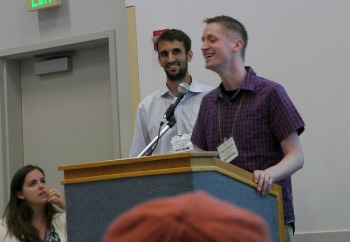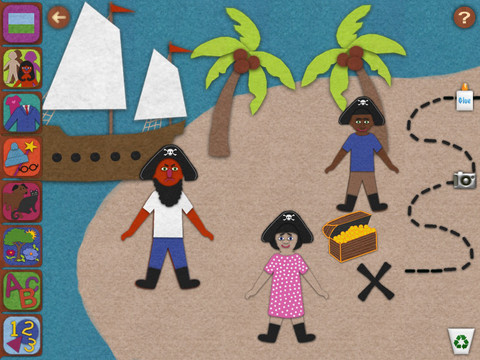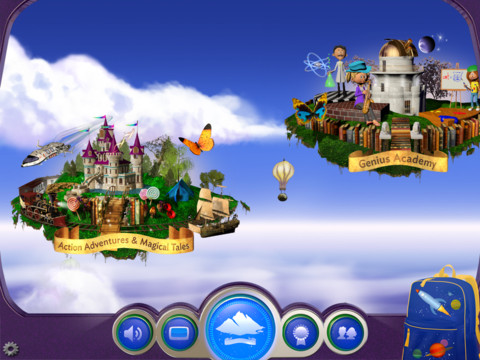What makes a great app? For one, “the graphics need to be awesome,” says Amy Graves, children’s librarian at Manchester (NH) City Library, “because it’s competing with the picture book [the child] has just read.”
That’s just one snippet of wisdom—flipping the notion of the primacy of technology over content—shared at “There’s an App for That: Using Technology to Enhance Children’s Librarianship,” a June 24 program at the American Library Association annual conference in Anaheim, CA.

Gretchen Caserotti, Travis Jonker, and John Schumacher
Graves, and fellow presenters, Gretchen Caserotti, assistant director for public services, Darien (CT) Library, John Schumacher, school library director, Brook Forest (IK) Elementary School, and Travis Jonker, elementary media specialist, Wayland Union Schools, MI, offered a particular take on apps: how they can best be used with kids in the context of library services, both in public libraries and schools.
Among the most “seamless” apps in the storybook category: Harold and the Purple Crayon, according to Jonker. The tablet version of the classic picture book by Crockett Johnson provides an intimate reading experience and works particularly well in a one-to-one setting, he says. While a favorite among Jonker’s students, The Monster at the End of this Book has Grover doing all the talking, therefore posing a dilemma, where the librarian’s art of live storytelling could be subsumed by the app.
As for John Schumacher, his second graders make a beeline for Bobo Explores Light. “It’s not often that kids go for a nonfiction app,” he says, but this one is “thoughtfully designed and so, so much fun to explore.” Covering 21 topics related to the science of illumination, Bobo features an excellent table of contents and does a good job of integrating games and text, says Schumacher. Other favorites of “Mr. Schu”: Pete the Cat, “the Justin Bieber of my school” and Fancy Nancy Dress Up. “I’ve never had a boy refuse to do this or make a negative comment,” says Schumacher, “because I teach in my library that books don’t have genders.”

Felt Board app
Participation is also the objective in public libraries, where Graves and Caserotti integrate apps into traditional library programming. Graves tapped her favorite apps for using with very young children. They include: SimpleSort, Funky Fruitilicious, and Felt Board. She particularly likes Peekaboo Barn for its authentic animal sounds. And “it doesn’t announce what the animal is. Other apps don’t give you a chance to guess,” says Graves.
Caserotti’s philosophy around children’s tech at Darien? “Let them play and let them make stuff,” she says, advising that organizers take advantage of teachable moments when they arise and not segregate technology. At Darien, adult services hosts an “Appy Hour” for sharing these resources with patrons, including parents. “It opens the concept of reader’s advisory to apps,” says Caserotti, who has recently helped launch Coderdojo, a local club where kids can learn how to code.

Reading Rainbow app
The panel also addressed one of the most anticipated products, the just released Reading Rainbow app. The interface, which presents book genres as islands, where users can then find digital titles and related video “seems really thought out,” says Jonker. “They made a conscious effort to break away from the reading app as a bookshelf.”
What he wishes they added? A link from the app to see if featured titles are available at the public library. We’ll see if Levar Burton responds to Jonker’s request, which he issued in a tweet to the popular host of the franchise.
Slides are available of both the public library and school presentations.



While I love hearing what apps are working well in libraries, what I haven’t’ seen in articles is HOW librarians are implementing the apps. With 5 iPads and 25 students, I would love to learn more about the logistics of implementation. Thanks!
Thanks, Leslie. We’re planning to do just that in future pieces – per request from many of our users, we will be providing more practical information around applying digital technologies. Anything else? What specifically are you interested in learning more about? Let us know.
Kathy,
Thanks for responding. I’m a school librarian (k-6), so specifically interested in schools, but would love any info! Interested in: how does the school librarian structure the iPad program? Are they just used for exploration time or used for specific projects. Every week? When used for free time, are the apps introduced to the kids or are they just let loose to explore? Check out to the teachers? Check out to the students? Crowd control when you have 5 iPads and 20 kids who want to use them. How are the apps organized on the device? What guidelines are given to the students? Whew! Obviously every library is different depending on the number of devices and learning goals, but would love to hear the “big picture” of some programs since I am just getting started. Thanks!
I am responding to your note asking for specific requests about IPad application. I would like suggestions about how to use the IPad to encourage reluctant readers at the grades 7-10 level.
Thank you.
I am VERY interested in iPads applications for K-5th librarian